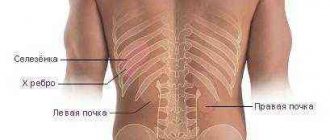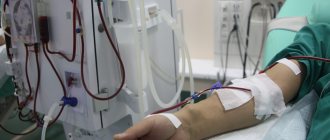Systemic kidney diseases occur in 3-4% of patients suffering from renal pathologies. Diseases are complicated by the involvement of all vital organs in the process, which often causes disability in the adult population and can lead to death. This factor explains the importance of timely contacting a doctor to make a diagnosis and begin therapeutic treatment. Rational selection of medications guarantees the effectiveness of treatment of kidney damage in CTD.
Kidney damage in systemic connective tissue diseases
Systemic kidney diseases occur in 3-4% of patients suffering from renal pathologies. Diseases are complicated by the involvement of all vital organs in the process, which often causes disability in the adult population and can lead to death. This factor explains the importance of timely contacting a doctor to make a diagnosis and begin therapeutic treatment. Rational selection of medications guarantees the effectiveness of treatment of kidney damage in CTD.
Systemic connective tissue diseases: general concepts and types
Systemic diseases are a group of nosological independent diseases that have similar etiologies.
Systemic diseases are a group of nosological independent diseases that have similar etiologies, pathogenesis and clinical manifestations. Treatment is often carried out with similar drugs. The common feature of all CTDs is latent viral infection. The dependence of the development of diseases is explained by the tissue tropism of viruses, the genetic predisposition of the patient, which is expressed in the carrying of certain histocompatibility antigens.
The triggering mechanisms are not specific; most often, lesions occur against the background of hypothermia, vibration, viral infection and violation of vaccination technology. The surge of immunoreactivity in the body of a patient predisposed to the disease is not able to fade away on its own, as a result of which the affected cells form a self-sustaining inflammatory process, leading to the degradation of the system of specialized renal structures to the level of collagen-enriched fibrous tissue.
Important! All CTDs are characterized by damage to epithelial compounds: skin, mucous membranes, and exocrine glands. Muscular structures, synovial and serous membranes are also involved. In addition, kidney damage in systemic connective tissue diseases is accompanied by secondary immune complex vasculitis of medium and small vessels
The close connection of all diseases is confirmed by the manifestation of signs of several pathologies from this group. For example, a patient may exhibit symptoms of lupus erythematosus, scleroderma, and mixed diffuse pathologies of connective tissue. And now a little more about what pathological systemic kidney diseases exist.
Systemic lupus erythematosus
This is a diffuse pathology of connective tissues with the formation of autoantibodies to structural elements of tissues and components of cell nuclei.
This is a diffuse pathology of connective tissues with the formation of autoantibodies to structural elements of tissues and components of cell nuclei. Most often occurs in patients who inherit compliment deficiency; in addition, the reasons are:
- nonspecific effects;
- pregnancy;
- poisoning with drugs, toxins, poisons.
Kidney pathology is especially common in women aged 15-35 years. The clinical picture varies as follows:
- Acute, the characteristic symptoms of which are: sudden increase in body temperature, joint pain, changes in the skin. The dynamic course does not allow delaying treatment; after 1-2 years, patients die without treatment.
- Subacute – the most common and manifests itself as a gradual deterioration of the patient’s condition. Decreased ability to work, joint pain occurs in waves, without any significant exacerbations. Multiple organ changes incompatible with life occur after 2-4 years.
- Chronic, in which the moment of onset of the pathology is difficult to establish. For a long time, the disease remains unrecognized, the symptoms are subtle and are often disguised as polyarthritis or polyserositis. The clinical picture becomes clear after 5-10 years.
The prognosis is favorable only with timely initiation of treatment.
Systemic scleroderma
This is a connective tissue disease, aggravated by fibrosclerotic changes in the skin.
This is a connective tissue disease, aggravated by fibrosclerotic changes in the skin and internal organs. The disease affects patients with antigens and chromosomal aberrations. The diffuse form of the pathology affects the surface of the skin, but lesions of internal organs are detected earlier and the entire vital system is involved in the process, the kidneys and lungs are especially severely affected.
The disease has an acute, subacute, chronic form:
- Acute – dynamics over the course of a year, damage to the skin, vital organs, and typical deviations in laboratory test results.
- Subacute progresses a little more slowly, and skin lesions, vasomotor disorders and dysfunction of internal organs are also observed.
- Chronic has a sluggish, gradual onset, progresses for a very long time and most often a limited type of pathology is formed. Over time, patients show signs of hypertension and pulmonary fibrosis. The typical onset is changes in the skin. The patient sees thickenings on the fingers and hands, then the areas become denser and further sclerosis causes thinning of the skin - this is the atrophic phase, in which the skin becomes smooth, taut and very dry.
The pathology is complemented by pain, fatigue, and decreased muscle and motor activity. Prognosis depends on the pathomorphological variant of the disease. If this is a limited form, then the prognosis is favorable; diffuse requires the fastest possible treatment of internal organs: kidneys, heart, lungs.
Periarteritis nodosa
A systemic disease that affects men in old age.
A systemic disease that affects men in old age. The clinical picture is characterized by polymorphism, in which fever, weight loss are observed, joints, skin, heart, lungs, central nervous system, peripheral nervous system and other vital structures of the body are affected. Kidney pathology is observed in 80% of patients; the symptoms depend on histological changes in the structural renal connections.
With a renal infarction, the prognosis for patients is unfavorable; the pathology also leads to hypertension and renal failure.
Hemorrhagic vasculitis
The pathology affects blood microcirculation and involves small vessels of the skin, joints, kidneys, and digestive tract. Signs of the disease are: weakness, loss of appetite, weight loss, change in skin color.
Dysfunctions of other organs are observed much less frequently. GV can provoke the development of arterial hypertension and renal failure. The prognosis is poor for increased proteinuria and early onset hypertension. In all other cases, the patient, with timely treatment, is guaranteed a complete recovery.
Granulomatosis
Characteristic manifestations: necrotizing changes in small arteries, veins of the upper respiratory tract, pulmonary vessels.
Most often, cases of renal disease occur in men 15-40 years old. Characteristic manifestations: necrotizing changes in small arteries, veins of the upper respiratory tract, pulmonary vessels, which are affected by foci of infiltration with the formation of cavities. Signs: fever, sudden weight loss, myalgia, nephritis.
Clinical signs appear after a few months and are expressed by proteinuria and erythrocyturia. The disease has a dynamic development and is characterized by renal failure already at the first stage of manifestation of the pathology.
Treatment methods?
Treatment of kidney damage in systemic diseases is challenging due to the variety of clinical and morphological manifestations and unpredictable consequences. The effectiveness of therapy requires an individual approach to each disease, identifying the underlying causes and the presence of aggravating factors.
After examination and clarification of the nature of the renal lesion, patients are admitted to the hospital. The condition of constant observation is mandatory, as is control of therapeutic measures. It is necessary to maintain a diet and change drug treatment if side effects occur: the risk of developing additional pathologies often outweighs the use of particularly strong drugs, which explains the duration of treatment for patients.
lecheniepochki.ru
Symptoms of autoimmune glomerulonephritis
The first symptoms appear 1-3 weeks after a person has suffered an infectious disease.
The first symptoms appear 1-3 weeks after a person has suffered an infectious disease. Headaches may begin, blood pressure and body temperature may increase. The removal of fluid from the body worsens, which causes a decrease in the formation of urine and the appearance of swelling of the body. There are traces of blood in the urine (reminiscent of the color of “meat slop”). Pain appears in the lower back and abdomen, and vomiting may begin.
When autoimmune glomerulonephritis becomes chronic, high blood pressure becomes persistent, and at the same time morning edema becomes permanent. Laboratory tests of urine may detect protein. The daily amount of urine decreases sharply, and the pain becomes aching in nature.
Attention! With any form of autoimmune glomerulonephritis, pain may be absent. It is necessary to focus on tests and other types of diagnostics, since other symptoms can occur hidden (latent).
Read more about the general symptoms of glomerulonephritis.
Kidney pathology in systemic connective tissue diseases
Clinic » Services » Nephrology » Treatment of kidney diseases » Kidney damage in systemic connective tissue diseases
Almost 4% of the world's adult population suffers from various connective tissue diseases. A distinctive feature of such diseases is the gradual involvement of other organs in the pathological process. Moreover, the leading place is occupied by kidney damage.
More often, systemic kidney damage progresses with:
- systemic lupus erythematosus,
- Wegener's granulomatosis,
- systemic vasculitis,
- rheumatism,
- Goodpatcher's syndrome,
- rheumatoid arthritis,
- periarteritis nodosa,
- systemic scleroderma,
- other connective tissue diseases.
Find out the cost of a consultation and make an appointment with a doctor by phone:
+7 or
Registration online
Despite the variability of nosological forms, kidney pathologies in systemic diseases are predominantly characterized by the development of different types of glomerulonephritis, amyloidosis and interstitial nephritis. Pathological changes in the renal structures vary from isolated changes in the composition of urinary sediment to severe nephrotic or nephritic syndrome, or chronic renal failure.
Causes
Nephrological pathologies that arise against the background of systemic diseases are the result of complex metabolic changes. As a result, a progressive immunoinflammatory process develops in the renal tissues, accompanied by urinary syndrome, which is often associated with arterial hypertension.
The course of systemic kidney damage has several stages of development:
- asymptomatic (latent),
- pronounced clinical manifestations,
- terminal stage.
Also, the course of these pathologies is characterized by a certain phase pattern:
- proteinuria,
- development of nephrotic syndrome,
- edematous-proteinuric phase,
- development of arterial hypertension,
- pronounced uremia (terminal phase).
Frequent stress, poor environment, sedentary work, physical inactivity, unbalanced diet - the combination of these factors is a trigger for the development of secondary nephropathies. Recently, experts are faced with the fact that the percentage of kidney damage in systemic connective tissue diseases has increased significantly. In order to promptly diagnose pathology and minimize possible damage, it is very important to undergo systematic examinations by a nephrologist.
Symptoms
Kidney damage in systemic connective tissue diseases does not manifest itself for a long time. As a rule, the patient complains only about the symptoms of the underlying disease that caused the kidney disorders. But laboratory tests show proteinuria, indicating kidney damage.
With the development of the pathological process, symptoms increase, and the following clinical manifestations arise:
- headache;
- persistent swelling;
- arterial hypertension;
- kidney pain;
- loss of appetite, nausea, vomiting;
- dyspnea;
- arrhythmia.
The last stage of kidney damage in systemic diseases is characterized by the appearance of all clinical signs of chronic renal failure.
Diagnosis of the disease
The criteria for diagnosing kidney damage in systemic connective tissue diseases are signs of damage not only to the kidneys, but also to other organs - the nervous system, joints, blood vessels, heart, digestive organs, etc., that is, the systemic nature of the damage. Typically, diagnosing secondary nephropathies does not cause difficulties and is not particularly different from diagnosing interstitial nephritis, glomerulonephritis or amyloidosis.
Differential diagnosis may be difficult if changes in laboratory tests are subtle. In such cases, to make the correct diagnosis, a comprehensive laboratory and instrumental study is performed using a wide range of techniques, including kidney biopsy.
The many years of experience of nephrologists at the Clinic of Modern Medicine allows us to accurately diagnose and successfully treat any renal pathology. And advanced diagnostic equipment makes it possible to detect systemic kidney damage at the initial stage, when there are no pronounced clinical symptoms.
Treatment of kidney damage in systemic connective tissue diseases
Treatment of renal lesions in systemic connective tissue pathologies is a very complex and lengthy task. Renal pathologies in such diseases are characterized by variability in clinical and morphological manifestations and often unpredictability of the course.
The nephrologist approaches the choice of therapeutic tactics strictly individually. Drug therapy is mainly aimed at treating the underlying disease, eliminating symptoms of damage to the renal structures and normalizing renal function. The dietary regimen and rational therapy are selected depending on the clinical type of nephropathy.
The capabilities of modern nephrology make it possible to cope with almost any kidney pathology, regardless of the nature of the damage to the renal structures, and timely contact with a specialist will significantly shorten the treatment process and allow you to take control of the disease at an early stage of development.
The presence of any systemic connective tissue disease is a direct indication for regular examinations by a nephrologist. Remember, timely detection of pathology is an opportunity to successfully and quickly restore kidney functionality and prevent irreversible damage to renal structures.
Our doctors
www.ksmed.ru
Kidney damage in SLE
- Blood in urine.
- Swelling (face - mainly around the eyes, especially in the morning; feet and legs).
- Thirst.
- Pain in the lumbar region.
- Increased arterial (blood) pressure.
- With the development of renal failure, the following are observed: a decrease in the amount of urine excreted;
- general signs of intoxication - nausea, vomiting, muscle weakness, headache;
- dry and itchy skin;
- dyspnea;
- diarrhea (diarrhea);
- decreased visual acuity.
- Rapidly progressive lupus nephritis - characterized by severe edema, high protein content in the urine, low protein levels in the blood, high cholesterol levels, increased arterial (blood) pressure, difficult to treat, and early (in the first months) development of renal failure. The prognosis is unfavorable.
- Nephritis with nephrotic syndrome (nephrotic form) - protein in the urine is determined to a lesser extent, disturbances in the levels of protein and cholesterol in the blood are less pronounced, an increase in blood pressure and the presence of blood in the urine are more often observed.
- Active lupus nephritis with severe urinary syndrome - a moderate amount of protein in the urine, the appearance of red blood cells and leukocytes in the urine. High blood pressure is possible but easily treatable.
- Nephritis with minimal urinary syndrome - a small amount of protein, red blood cells and white blood cells in the urine. Blood pressure usually remains normal. Kidney function is preserved. The most favorable type of kidney damage.
Systemic lupus erythematosus (SLE) is an autoimmune disease characterized by a malfunction of the immune system: for unknown reasons, the body begins to perceive its own cells as foreign and produce antibodies to them.
As a result of an attack by antibodies on normal cells of the body, so-called immune complexes are formed, which circulate throughout the body and are deposited in various organs and tissues, leading to the development of chronic inflammation in them. LookMedBook reminds: the sooner you seek help from a specialist, the greater your chances of maintaining health and reducing the risk of complications:
- Analysis of disease complaints (pain in the lumbar region, swelling in the face, blood in the urine).
- Analysis of the medical history (history of development) of the disease - asking about how the disease began and progressed.
- General examination (examination of the skin, palpation of the kidney area).
- General urinalysis - allows you to detect protein, red blood cells, and white blood cells in the urine.
- Urinalysis according to Nechiporenko (detection of a hidden inflammatory process in the urinary system, it consists of determining the number of leukocytes and red blood cells in the urine).
- Zimnitsky test (allows you to determine the ability of the kidneys to concentrate urine).
- Analysis of nitrogen excretion function of the kidneys (level of urea and creatinine in the blood).
- Determination of the level of glomerular filtration (Reberg-Tareev test) - is carried out to assess the excretory capacity of the kidneys.
- Kidney biopsy.
- A consultation with a nephrologist is also possible.
- Treatment of the underlying disease – systemic lupus erythematosus.
- Diet with limited salt and protein.
- During the period of exacerbation of the disease - bed rest, limitation of physical activity.
- Glucocorticosteroid hormones, cytostatics, aminoquinoline drugs (to suppress autoimmune inflammation).
- For edema, high arterial (blood) pressure - diuretics.
- Hemodialysis (a method of purifying the blood from nitrogen metabolism products using special devices) – with the development of renal failure.
- Kidney transplantation – if the above treatment methods are ineffective and renal failure develops.
- If a secondary infection occurs, antibiotics are used.
- Attachment of a secondary infection.
- In the absence of timely, adequate treatment and the presence of severe, rapidly progressing kidney damage, renal failure may develop, including death.
- Adequate therapy for the underlying disease – systemic lupus erythematosus – is necessary.
- Timely treatment of infectious diseases.
- Elimination of foci of chronic infection.
- A balanced and rational diet (eating foods high in fiber (vegetables, fruits, herbs), avoiding canned, fried, spicy, hot foods).
- Frequent split meals (5-6 times a day in small portions).
- Avoid hypothermia.
- Quitting bad habits (alcohol).
lookmedbook.ru
The real causes of autoimmune diseases
If we summarize all of the above and add a little purely scientific information, then the causes of autoimmune diseases are as follows:
Long-term immunodeficiency resulting from a harmful environment, poor nutrition, bad habits and chronic infections Imbalance in the interaction of the immune, nervous and endocrine systems Congenital and acquired abnormalities of stem cells, genes, the organs of the immune system themselves, as well as other organs and groups of cells Cross-reactions immune system against the background of immunodeficiency.
It is known that in “backward” countries, where people eat poorly and mostly plant foods, autoimmune diseases are poorly developed. It is now known for sure that an excess of chemically processed foods, fatty and protein foods, together with chronic stress, gives rise to monstrous disruptions of the immune system.
Therefore, the “Sokolinsky System” always begins with cleansing the body and supporting the nervous system, and against the background of this, you can try to calm the immune system.
You can read about our special view on the causes of autoimmune diseases here
Autoimmune diseases still remain one of the most important and still unresolved problems of modern immunology, microbiology and medicine, so their treatment is still only symptomatic. It’s one thing if the cause of a serious illness is an error of nature, and quite another thing when the prerequisites for its development are created by the person himself, who does not care about his health in any way. Take care of yourself: your immune system is as vindictive as it is patient.
Kidney damage in systemic vasculitis
Home / Arterial hypertension / Bilateral renal diseases of a predominantly immunological nature, data from morphological studies / Kidney damage in systemic vasculitis
The kidneys, as a rule, are involved in the process with systemic vasculitis. In some cases, especially with periarteritis nodosa and systemic lupus erythematosus (SLE), kidney damage comes to the fore and in the early period of the disease may appear to be an isolated process.
This gives practical significance to the issues of differential diagnosis of systemic vasculitis in various types of renal syndromes.
In periarteritis nodosa (Kussmaul-Mayer disease), two types of kidney damage are distinguished: vascular and glomerular. In the first, medium-sized arteries are involved - intralobular and arcuate - with their thrombosis, the formation of aneurysms and ruptures, leading to the development of renal infarctions.
The second type of lesion occurs with a full-blown clinical picture of subacute, less often acute or chronic glomerulonephritis. Hypertension occurs in a number of other syndromes, sometimes only in the late period, simultaneously with renal failure. With the vascular type of the process, disruption of intrarenal hemodynamics often leads to hyperplasia of the JGA in certain areas of the kidneys and to hyperreninemia.
Hypertension becomes resistant to treatment, and urinary syndrome (albuminuria, hematuria) is very mild. A symptom complex arises that provides grounds for diagnosing malignant hypertensive syndrome.
Establishing the true nature of the disease is facilitated in cases where the process occurs in waves with fever, inflammatory changes in the blood, eosinophilia, hypergammaglobulinemia and extrarenal manifestations: polyneuritis, nodules along the peripheral vessels, gastric ulcers.
However, an isolated form of the disease has been described—renal periarteritis nodosa—the timely diagnosis of which is possible only as a result of histological examination of a kidney biopsy. In SLE, the kidneys are among the most commonly affected organs.
Clear symptoms of their involvement in the process are observed in at least 2/3 of cases. As a rule, symptoms of diffuse glomerulonephritis with a subacute course occur. Histologically, various changes such as intra- and extracapillary nephritis with areas of hyalinosis and amyloid degeneration are determined. More often than with other diseases, the phenomenon of “wire loops” occurs. Hypertensive syndrome is not, as a rule, one of the leading ones and occurs only in 10 - 20% of patients.
Its interpretation is facilitated by extrarenal symptoms of a systemic disease (“butterfly”, micropolyadenitis, polyarthralgia, damage to the serous membranes), characteristic biochemical changes, hypoprotein and hypergammaglobulinemia, it is possible to detect LE cells, antinuclear factor. The idea of SLE is suggested by the young age of patients, especially women, and high fever.
“Arterial hypertension”, E.E. Gogin, A.N. Senenko, E.I. Tyurin
Further on topic:
www.medkurs.ru










